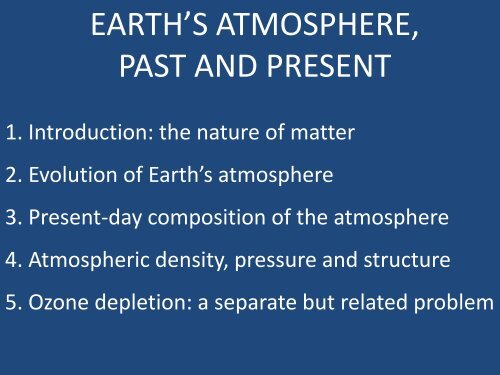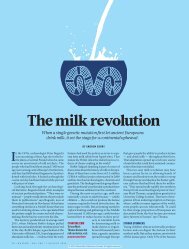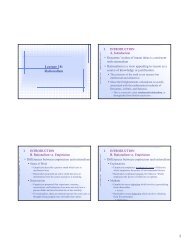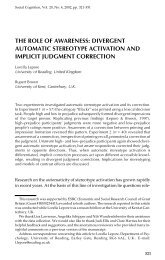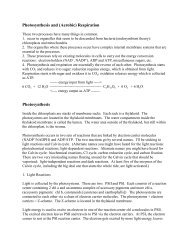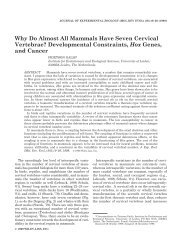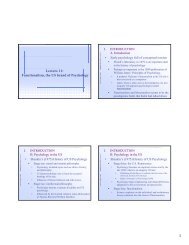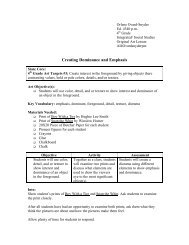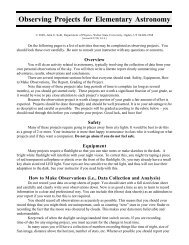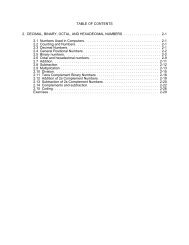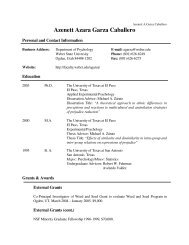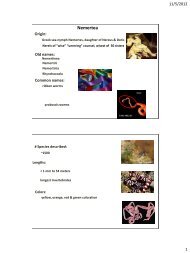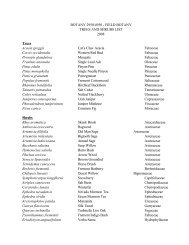earth's atmosphere, past and present - Weber State University
earth's atmosphere, past and present - Weber State University
earth's atmosphere, past and present - Weber State University
You also want an ePaper? Increase the reach of your titles
YUMPU automatically turns print PDFs into web optimized ePapers that Google loves.
EARTH’S ATMOSPHERE,<br />
PAST AND PRESENT<br />
1. Introduction: the nature of matter<br />
2. Evolution of Earth’s <strong>atmosphere</strong><br />
3. Present-day composition of the <strong>atmosphere</strong><br />
4. Atmospheric density, pressure <strong>and</strong> structure<br />
5. Ozone depletion: a separate but related problem
Earth’s <strong>atmosphere</strong>: a thin envelope of gases.<br />
Source: <strong>Weber</strong> <strong>State</strong> <strong>University</strong> HARBOR balloon flight, August 2009.
THE NATURE OF MATTER:<br />
Elements <strong>and</strong> compounds, atoms <strong>and</strong> molecules.<br />
Chemical element: A pure chemical substance composed<br />
of atoms with the same number of protons in the atomic<br />
nucleus (atomic number).<br />
Source: International Union of Pure <strong>and</strong> Applied Chemistry Compendium of Chemical<br />
Terminology (Gold Book), http://goldbook.iupac.org/index.html.
Schematic showing the structure of an oxygen atom.<br />
8 electrons (-)<br />
Nucleus:<br />
8 protons (+)<br />
(= atomic number)
THE NATURE OF MATTER:<br />
Elements <strong>and</strong> compounds, atoms <strong>and</strong> molecules.<br />
Chemical element: A pure chemical substance composed<br />
of atoms with the same number of protons in the atomic<br />
nucleus.<br />
Chemical compound: A pure chemical substance<br />
consisting of two or more different chemical elements<br />
that can be separated into simpler substances by<br />
chemical reactions.<br />
Source: International Union of Pure <strong>and</strong> Applied Chemistry Compendium of Chemical<br />
Terminology (Gold Book), http://goldbook.iupac.org/index.html.
Structure of a water molecule. Source: Christopherson, 2003, p. 183.<br />
Chemical formula: H 2 O<br />
Two hydrogen atoms<br />
One oxygen atom
Chemical compounds in Earth’s <strong>atmosphere</strong>:<br />
molecules of five major greenhouse gases.<br />
Source: Mann <strong>and</strong> Kump, 2009, p. 14.
Present-day<br />
composition<br />
of Earth’s<br />
<strong>atmosphere</strong>.<br />
Source: Mann <strong>and</strong> Kump, 2009, p. 12.
Structure of a water molecule. Source: Christopherson, 2003, p. 183.<br />
POSITIVE<br />
CHARGE<br />
HYDROGEN<br />
(H + )<br />
HYDROGEN<br />
(H + )<br />
OXYGEN<br />
(O 2- )<br />
NEGATIVE CHARGE
Physical states <strong>and</strong> phase changes of water.<br />
Source: Christopherson, 2009, p. 181.
THE NATURE OF MATTER:<br />
Elements <strong>and</strong> compounds, atoms <strong>and</strong> molecules.<br />
Isotope: Atoms of the same element having the same<br />
atomic number but different mass numbers (atomic<br />
mass).<br />
Source: Mann <strong>and</strong> Kamp, 2009, p. 201; Houghton, 2009, p. 422.
Schematic showing the structure of an oxygen atom.<br />
8 electrons (-)<br />
Nucleus:<br />
8 protons (+)<br />
8, 9, or 10 neutrons<br />
Atomic number = 8<br />
Atomic mass (mass number) = 16, 17 or 18 ( 16 O, 17 O or 18 O)
EVOLUTION OF EARTH’S ATMOSPHERE<br />
(Source: After Christopherson, 1997)<br />
Age<br />
(bn. yrs BP)<br />
Composition<br />
Features<br />
4.6 to 4.0 H 2 O, HCN, NH 3 ,<br />
CH 4 , S, Cl, others<br />
4.0 to 3.3 At 4.0: H 2 O, CO 2 ,<br />
N 2 , S, hydrocarbons,<br />
little/no free O 2<br />
3.3 to 0.6 At 3.0: CO 2 , H 2 O,<br />
N 2 ,
HYDROSPHERE<br />
BIOSPHERE<br />
ATMOSPHERE<br />
LITHOSPHERE
Evolution of Earth’s <strong>atmosphere</strong> over<br />
billions of years shows that<br />
composition is DYNAMIC, not static,<br />
i.e. it can <strong>and</strong> does change over time.
Present-day<br />
composition<br />
of Earth’s<br />
<strong>atmosphere</strong>.<br />
Source: Mann <strong>and</strong> Kump, 2009, p. 12.
Changes in greenhouse gas<br />
concentrations in the <strong>atmosphere</strong>,<br />
10,000 years ago to 2005 AD.<br />
Source: Mann <strong>and</strong> Kump, 2009, p. 33.
Changes in<br />
greenhouse gas<br />
concentrations in<br />
the <strong>atmosphere</strong>,<br />
1000 to 2001 AD.<br />
Source: IPCC, 2001. See also<br />
Houghton, 2009, pp. 39 <strong>and</strong> 52.
Recent carbon<br />
dioxide<br />
increases in<br />
the context of<br />
the last 1000<br />
years.<br />
Source: Arctic Climate<br />
Impact Assessment, 2004.
Changes in carbon dioxide concentrations in the<br />
<strong>atmosphere</strong>, 10,000 years ago to 2005 AD.<br />
Source: Houghton, 2009, p. 39.
Changes in methane <strong>and</strong><br />
nitrous oxide concentrations<br />
in the <strong>atmosphere</strong>, 10,000<br />
years ago to 2005 AD.<br />
Source: Houghton, 2009, p. 52.
Atmospheric concentration of CFC-11. Source: IPCC, 1996.
Smog in the Wasatch Front/Salt Lake City area.<br />
Source: Salt Lake Tribune, 2002.
Smog in the Wasatch<br />
Front/Salt Lake City<br />
area, during <strong>and</strong> after<br />
an inversion.<br />
Source: Salt Lake Tribune, 2007.
Total atmospheric aerosols, average August-October 2001.<br />
Source: MODIS satellite observations, Houghton, 2009, p. 59.
Pollution’s effects on clouds: more reflective, less rainy.<br />
Source: Houghton, 2009, p. 61.
Computer model simulations of climate warming<br />
with <strong>and</strong> without effects of sulphate aerosols (SO 4 ).<br />
No sulphate<br />
aerosols<br />
Sulphate<br />
aerosols<br />
constant at<br />
2000 level<br />
Source: Houghton, 2009, p. 60.
Source: Christopherson,<br />
2009, p. 64.
Height in<br />
kilometres<br />
Height in<br />
miles<br />
Source: Christopherson, 2009, p.64.<br />
Atmospheric pressure in<br />
millibars
Layers in the <strong>atmosphere</strong>.<br />
Source: Mann <strong>and</strong> Kump, 2009, pp. 12 <strong>and</strong> 38.
Source: Christopherson, 2009, p63.<br />
Height in<br />
kilometres<br />
Height in<br />
miles<br />
Thermosphere<br />
Mesosphere<br />
Stratosphere<br />
Troposphere<br />
Temperature
Rising air flattens out when it hits the tropopause:<br />
an anvil cloud (cumulonimbus incus).<br />
Source: NASA Earth Science Picture of the Day, http://epod.usra.edu
Atmospheric concentration of CFC-11. Source: IPCC, 1996.
Antarctic ozone hole as measured by NASA<br />
TOMS instrument, September 11 2003.
Source:<br />
Christopherson,<br />
2009, p. 71.


